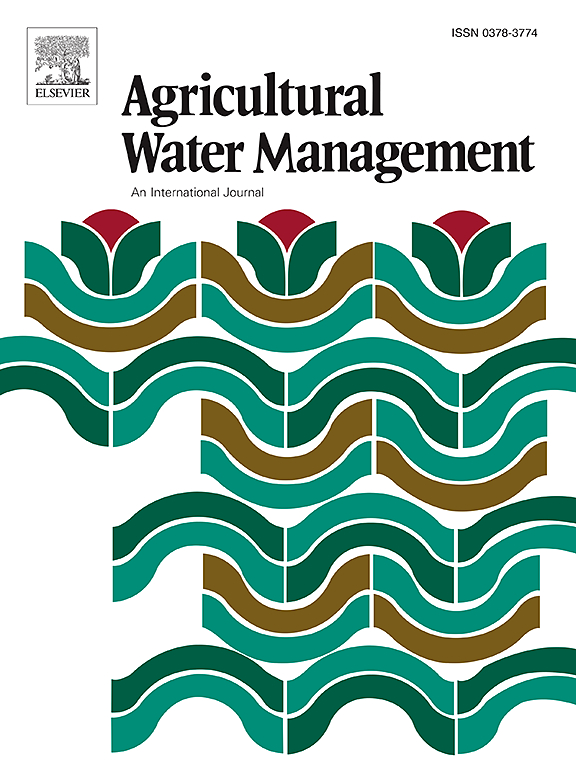极端降雨和土壤耗水量差异会增加下部果枝的产量损失,降低不同播种期的棉花水分生产率
IF 5.9
1区 农林科学
Q1 AGRONOMY
引用次数: 0
摘要
提高栽培棉花对气候变化下极端气候事件的适应能力可促进棉花的可持续生产。极端降雨导致棉花大幅减产,这可能与土壤耗水量(SWC)和产量垂直分布的变化有关,但相关研究仍然很少。本文通过为期两年的棉花播期试验,结合地质统计学、传感器技术、空间网格法和主成分分析法,分析了极端降雨年份(2021年)和正常年份(2022年)棉花对土壤水的利用情况。探讨了极端降雨下棉花减产的原因以及提高棉花生产对极端降雨适应性的策略。在极端降雨条件下,棉花的形态发生和生殖器官发育受到抑制。在极端降雨条件下,不同播种期棉花的SWC积累及其与生物量积累的关系表现出与正常年份几乎相反的特征。与此同时,两年的产量也随着播种期的变化呈现出相反的趋势。棉花产量的垂直分布(即上、中、下果枝)存在一种权衡策略。极端降雨降低了下部果枝的产量,提高了上部果枝的成铃率,这与籽棉产量、皮棉产量和水分生产率(WP)密切相关。优化棉花播种期(在本研究中应以早播为宜)可提高棉花生产在极端降雨条件下的适应性,但还需要进一步的长期研究。本研究强调了气候智能型农业的关键实践,对棉花生产的可持续发展具有参考价值。本文章由计算机程序翻译,如有差异,请以英文原文为准。
Extreme rainfall and soil water consumption differences increase yield shedding at lower fruiting branches, reducing cotton water productivity under different sowing dates
Improvement of cultivated cotton adaptability to extreme climate events under climate change promotes sustainable cotton production. Extreme rainfall leads to a significant decrease in cotton yield, which may be related to changes in soil water consumption (SWC) and the vertical distribution of yield, but relevant research is still scarce. Here, a two-year cotton sowing date experiment was conducted in which geostatistics, sensor technology, the spatial grid method, and principal component analysis were combined to analyze cotton utilization of soil water during extreme rainfall (2021) and normal (2022) years. The reasons for cotton yield reduction under extreme rainfall and strategies to improve cotton production adaptability to extreme rainfall were discussed. Under extreme rainfall, the morphogenesis and reproductive organ development of cotton were inhibited. The accumulation of SWC and its relationship with the biomass accumulation of cotton on different sowing dates under extreme rainfall exhibited nearly opposite characteristics to those in a normal year. Simultaneously, the two-year yield showed the opposite trend with the change in sowing date. There existed a trade-off strategy for the vertical distribution (i.e., on the upper, middle and lower fruiting branches) of cotton yield. Extreme rainfall reduced the yield at lower fruiting branches and increased the boll-forming rate of the upper fruiting branches, which was closely related to seed cotton yield, lint yield and water productivity (WP). Optimizing the cotton sowing date (early sowing should be appropriate in this study) may improve the adaptability of cotton production under extreme rainfall, but further long-term studies are needed. This study highlights the critical practice of climate-smart agriculture and has reference value for the sustainable development of cotton production.
求助全文
通过发布文献求助,成功后即可免费获取论文全文。
去求助
来源期刊

Agricultural Water Management
农林科学-农艺学
CiteScore
12.10
自引率
14.90%
发文量
648
审稿时长
4.9 months
期刊介绍:
Agricultural Water Management publishes papers of international significance relating to the science, economics, and policy of agricultural water management. In all cases, manuscripts must address implications and provide insight regarding agricultural water management.
 求助内容:
求助内容: 应助结果提醒方式:
应助结果提醒方式:


